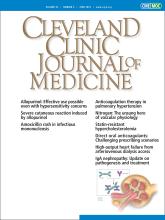Article Figures & Data
Tables
Condition Body mass index or weight ≥ 50 kg/m2
or > 150 kg40–49 kg/m2
or 120–150 kg< 18.5 kg/m2
or < 60 kgVenous thromboembolism Data limited Apixaban and rivaroxaban may preferably be used Data scarce, but DOACs may be used Atrial fibrillation Data limited Apixaban, rivaroxaban, and dabigatran can be used Apixaban is preferred; reduce dose to 2.5 mg twice daily if creatinine clearance > 1.5 mg/dL or age > 80, or both; other DOACs may also be considered Based on information from references 3 and 17.
Condition and direct oral anticoagulant Creatinine clearance, mL/min < 15 or on hemodialysis 15 to < 30 30 to < 50 ≥ 50 Nonvalvular atrial fibrillation Apixaban Not studieda 5 mg twice daily or
2.5 mg twice dailyb5 mg twice daily or
2.5 mg twice dailyb5 mg twice daily or
2.5 mg twice dailybEdoxaban Recommendations cannot be provided 30 mg once dailyc 30 mg once dailyc 60 mg once dailyd Rivaroxaban Not studiede Treat as moderate impairment; 15 mg once daily (not studied) 15 mg once daily 20 mg once daily Dabigatran Recommendations cannot be provided 75 mg twice dailyf 150 mg twice daily 150 mg twice daily Venous thromboembolism Apixaban No prospective clinical data on efficacy and safety No prospective clinical data on efficacy and safety 10 mg twice daily; transition to 5 mg twice daily after 7 days 10 mg twice daily; transition to 5 mg twice daily after 7 days Edoxaban Recommendations cannot be provided 30 mg once dailyc 30 mg once dailyc 60 mg once dailyd Rivaroxaban Avoid No prospective clinical data on efficacy and safety 15 mg twice daily; transition to 20 mg once daily after 21 days 15 mg twice daily; transition to 20 mg once daily after 21 days Dabigatran Recommendations cannot be provided Recommendations cannot be provided 150 mg twice daily 150 mg twice daily Note: Additional adjustments needed for concomitant use of P-glycoprotein or cytochrome P450 3A4 inhibitors, or both, are not included.
↵aExpected pharmacokinetic and pharmacodynamic profile as in ARISTOTLE (Apixaban for Reduction in Stroke and Other Thromboembolic Events in Atrial Fibrillation) trial.27
↵bReduce dose in patients with at least 2 of the following: age ≥ 80, body weight ≤ 60 kg, serum creatinine ≥ 1.5 mg/dL.17
↵cPatients with creatinine clearance < 30 mL/min were not included in randomized clinical trials.31
↵dDo not use in patients with creatinine clearance > 95 mL/min due to increased risk of ischemic strokes.19
↵eExpected pharmacokinetic and pharmacodynamic profile as in ROCKET AF (Rivaroxaban Once Daily Oral Direct Factor Xa Inhibition Compared With Vitamin K Antagonism for Prevention of Stroke and Embolism Trial in Atrial Fibrillation).28
↵fNot based on prospective clinical data.17
Based on information from references 17, 33, and 34.
Condition and direct oral anticoagulant Child-Pugh class A B C Nonvalvular atrial fibrillation Apixaban 5 mg twice daily
or 2.5 mg twice dailyaLimited clinical experience; recommendations cannot be provided Avoid Edoxaban 60 mg once daily Avoid Avoid Rivaroxaban 20 mg once daily Avoidb No clinical data available; avoid Dabigatran 150 mg twice daily Large intersubject variability, but no evidence of a consistent change in drug exposure; use with caution or avoid No clinical data available; avoid Venous thromboembolism Apixaban 10 mg twice daily; transition to 5 mg twice daily after 7 days Limited clinical experience; recommendations cannot be provided Avoid Edoxaban 60 mg once daily Avoid Avoid Rivaroxaban 15 mg twice daily; transition to 20 mg once daily after 21 days Avoidb No clinical data available; avoidb Dabigatran 150 mg twice daily Large intersubject variability, but no evidence of a consistent change in drug exposure; use with caution or avoid No clinical data available; avoid Note: Class A is mild hepatic impairment, B is moderate impairment, and C is severe liver disease. Additional adjustments needed for concomitant use of P-glycoprotein or cytochrome P450 3A4 inhibitors, or both, are not included.
↵aReduce dose in patients with at least 2 of the following: age ≥ 80, body weight ≤ 60 kg, serum creatinine ≥ 1.5 mg/dL.17
↵bDrug exposure and bleeding risk may be increased.17,37
Based on information from reference 36.
- TABLE 4
Direct oral anticoagulant use for treatment of venous thromboembolism and nonvalvular atrial fibrillation after bariatric surgery
Gastric banding All direct oral anticoagulants can be used because the gastrointestinal anatomy is preserved Gastric sleeve Apixaban may be a preferred option because of the intact duodenum; avoid rivaroxaban and dabigatran because they are predominantly absorbed in the stomach; edoxaban requires an acidic environment for optimal absorption, which may be altered Roux-en-Y gastric bypass
Biliopancreatic diversion with duodenal switchAll direct oral anticoagulants should be avoided due to inadequate absorption after extensive loss of the stomach and proximal small intestines






